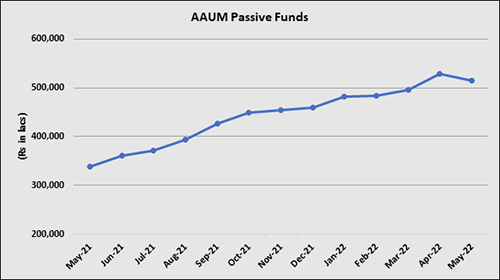Steps to Build a Passive-only Portfolio for Risk-averse Investors
Mitali Dhoke
Jun 23, 2022
Listen to Steps to Build a Passive-only Portfolio for Risk-averse Investors
00:00
00:00
It is difficult to make decisions for your investment portfolio in the face of volatile market conditions. The market has been significantly impacted by economic factors such as the recent increase in interest rates and excessive inflation. The ongoing conflict between Russia and Ukraine and other political events also contributed to the intensified market volatility.
Considering the current market environment, your total risk appetite may have altered to moderate or low, so it is necessary that you implement a wise and Risk-averse investment strategy. Many Risk-averse investors who want to eliminate stock-selection risks in a volatile market are seeking low-risk investment alternatives; you may consider using a passive investing method for your portfolio.
Passive investing offers the opportunity to invest in a diversified portfolio replicating the weights and returns of the underlying index, thereby minimising risk and volatility. Some of the common examples of passive investment strategies are Exchange-traded Funds (ETFs) and Index Funds. The extent of the presence of either in an investor's portfolio would hinge on your risk appetite and understanding of the market. For novice investors, Index Funds and ETFs make more sense than aiming for outperformance.
Due to less human intervention and no strategy surprises, passive funds eliminate the risk of fund managers' behavioural biases and may require less monitoring than their actively managed counterparts. There are highly rated passive funds in all main investment categories to choose from, whether you're seeking growth or value stocks or a combination of the two, large-cap, mid-cap or small-cap companies, foreign stocks, or even bonds.
Since, Passive investing is gaining momentum in India, and investors now have a wide range of low-risk passive investment options. A sizable number of actively managed mutual funds have underperformed their respective benchmark indexes in recent years amid the prolonged economic downturn caused by the pandemic. Additionally, it is difficult for fund managers to outperform the benchmark for actively managed funds, given the prevailing intensified market volatility. This, in turn, has elicited investors' interest towards passively managed funds.
Ranging from Index funds to Exchange-traded Funds (ETFs), passive investments gained ground in terms of both investor interest and assets under management.
Graph 1: Rise in Average Asset Under Management of Passive funds
 (Source: AMFI)
(Source: AMFI)
Investors are approaching passive products with renewed vigour due to various benefits, including market-linked returns, minimal tracking error, diversification, and transparency in the composition of the portfolio. According to AMFI's May 2022 report, there are around 275 passive mutual fund schemes in India, and this rally is expected to continue in the coming years.
Apart from the plain vanilla index and ETFs, theme-based-ETFs favouring concepts and trends have also gained traction. Earlier, most passive equity funds tracked only the large-cap index such as the Nifty 50 and S&P BSE Sensex, plus a few sectors such as banking, financial services, etc. To assist investors in building a diversified portfolio, mutual funds have recently introduced passive funds (Index funds/ETFs) that track a variety of categories (Equity, Debt, Gold and even Silver), themes (ESG, Global, EV, blockchain-technology), sectors (Pharma, IT), as well as other cutting-edge products.
 Image source: www.freepik.com
Image source: www.freepik.com
Join Now: PersonalFN is now on Telegram. Join FREE Today to get 'Daily Wealth Letter' and Exclusive Updates on Mutual Funds
However, investors may find it challenging to construct a portfolio of passive funds, given the slew of new passive funds being introduced in the market. There are numerous passive index possibilities, ranging from market-cap-based indices like Nifty50, Sensex, Nifty Next 50, and Nifty Midcap 150 to new factor-based indices (Value, Momentum, Quality, Low Volatility, etc.). But it is not necessary to hold an investment in each of these passive funds. To create a reliable, low-cost, passive investment portfolio, you only need 3 to 4 Index funds or ETFs as per your suitability.
Here are the steps you may follow to create a Passive-only portfolio with our assistance:
Step #1- Invest in Large-cap Index funds or ETFs
Risk-averse investors should always hold a sizable portion of their portfolio in large caps since they keep your portfolio stable during volatility. And for that, you have a choice of Nifty index under Nifty 100, Nifty 50, or Nifty Next 50, or different sectorial Nifty indices, or S&P BSE Sensex-based index funds. The Nifty 50 index tracks large-cap stocks, which are primarily significant blue-chip businesses. On the other hand, the Nifty Next 50 Index measures the performance of those companies that display the potential to become the next-generation market leaders.
Thus, each of these indices offers investors a much-needed advantage in their respective portfolios by promising sector diversification, strong liquidity, and decent return potential. Investors who are Risk-averse but still want equity exposure in their portfolios could invest in these dynamic benchmark indices. To increase exposure across market capitalisation, you might also invest in ETFs that track broader indices like the Nifty 500.
Step #2 - International Allocation
Once you have developed a well-diversified portfolio of passive funds in the domestic market, you might consider investing up to 5-10% of your portfolio in overseas passive funds that track indices such as Nasdaq 100, S&P 500, etc., to benefit from geographical diversification. For the majority of investors, having a US-based S&P500 index fund is sufficient as it offers good exposure to developed markets (or a NASDAQ-based fund if you are willing to take additional risk and volatility).
You can do this using the Fund of Funds schemes in India. By ensuring that the target fund's investing philosophy and risk profile align with the fund's purpose to produce long-term value, the fund manager makes investments in units of offshore mutual fund schemes. Thanks to the availability of numerous Fund of Funds that concentrate on international markets, Indian investors are now able to participate passively in a variety of sectors that are unavailable in domestic markets. Some of these global passive funds also target developing nations like China, Taiwan, etc. Global investing comes at the quadruple advantage of international opportunities, reduced risk, portfolio diversification, and better risk-adjusted global returns.
Step #3 - Invest in Debt Fund of Funds
Most investors may not realise that passive strategies are not only meant for equity-focused funds. Just like equity, passive debt funds such as target maturity ETFs/FOFs and Liquid ETFs also replicate the underlying debt benchmark. Experts say target maturity passive debt funds offer stable and predictable returns to investors. Since you do not sell this bond in between, the returns on this bond are not impacted by changes in interest rates that may happen in the intermittent period. Staying invested in a Debt Fund of Fund allows the investor to passively allocate your assets across duration and credit strategies without carrying the high risk of direct investment in bonds.
Changing times and investor needs demand innovation in every aspect of investing, be it offerings or channels. Today's market offers a wide range of investment opportunities. If one wants to jump on the growth train, the passive universe offers a variety of options. Passive investors build portfolios that track a market-weighted index rather than trying to time the market like active investors.
Passive funds offer a low-cost investment option for those looking to invest in equities and earn significant returns by tracking the relevant benchmark index and/or underlying fund. They do not have the appetite for high volatility, making it ideal for new investors who have just started their investment journey.
Table: Passive funds replicate the benchmark index performance
| Category |
Absolute (%) |
CAGR (%) |
| 1 year |
3 years |
5 years |
7 years |
| Category average: Index funds-Nifty 50 |
-1.34 |
10.63 |
10.61 |
9.94 |
| Benchmark: Nifty 50 |
-0.69 |
10.07 |
10.17 |
9.60 |
| Category average: Index funds-Nifty Next 50 |
-5.54 |
10.46 |
6.12 |
9.20 |
| Benchmark: Nifty Next 50 |
-5.87 |
10.54 |
6.39 |
9.28 |
| Category average: Index funds-Sensex |
0.5 |
10.73 |
11.29 |
10.10 |
| Benchmark: S&P BSE Sensex |
-0.8 |
10.24 |
10.92 |
9.78 |
Data as on June 23, 2022
(Source: ACE MF, PersonalFN Research)
Investors have started to recognise the potential of Index funds and ETFs as a result of rising levels of awareness, digital adoption, and product innovation over time. They combine the trading flexibility of a stock, coupled with diversification and the low costs of a mutual fund. Index funds and ETFs have received positive responses from new-age investors in part because they provide exposure to a basket of equities for a small fraction of the cost and have a number of advantages over direct investing.
However, gradually as the Risk-averse investor gains experience and is able to stomach more risk, passive investing should be seen more as an asset allocation tool. Investors can establish a diversified portfolio mix by assigning a portion of the portfolio to ETFs or Index funds, which help to moderate investment volatility. The remaining portion of the portfolio would then be invested in active funds. Investors could keep low-cost passive funds as their core portfolio and supplement it with worthy, actively managed mutual funds to fetch additional returns.
To conclude...
The debate over whether investors should use active or passive strategies in their portfolios has traditionally been viewed through the lens of outperformance. Actually, both can coexist in a portfolio where a blended strategy is used by the investor. To stay ahead of inflation, you may need a combination of investments to provide a potential return that can keep up with the effects of rising prices.
During a market crash, the actively managed funds get the opportunity to pick strong companies available at attractive valuations. As a result, these funds can significantly outperform the market in a bullish recovery. Having said that, investments in passively managed ETFs and Index funds help mitigate the risk of underperformance of actively-managed schemes. While selecting passive funds, pick the one with a low expense ratio and low tracking error to earn reasonably higher returns than the index over the long term. Thus investing in mutual funds utilising a blend of active and passive funds can help hedge against inflation.
The decision on whether to invest in an actively managed fund or passive fund, or a combination of both, should depend on the financial objective, investment horizon, and risk-taking ability of investors. Ideally, while investing in equity funds, ensure that you have a time horizon of at least 5-7 years to tide over the market volatility. And lastly, avoid investing in too many schemes as it can make it difficult to monitor its performance and eliminate the laggards.
PS: If you wish to select actively managed worthy mutual fund schemes, I recommend that you subscribe to PersonalFN's unbiased premium research service, FundSelect.
As a bonus, you get access to PersonalFN's popular debt mutual fund service, DebtSelect.
PersonalFN recommendations go through our stringent process that assesses both quantitative and qualitative parameters, providing you with Buy, Hold, and Sell recommendations on equity and debt mutual fund schemes. Read here for more details...
If you are serious about investing in rewarding mutual fund schemes, Subscribe now!
Warm Regards,
Mitali Dhoke
Jr. Research Analyst